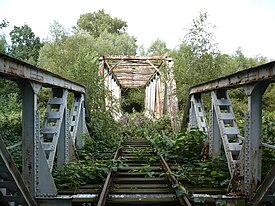Neisser Kreisbahn
| Neisser Kreisbahn | |||||||||||||||||||||||||||||||||||||||||||||||||||||||||||||||||||||||||||||||||||||
|---|---|---|---|---|---|---|---|---|---|---|---|---|---|---|---|---|---|---|---|---|---|---|---|---|---|---|---|---|---|---|---|---|---|---|---|---|---|---|---|---|---|---|---|---|---|---|---|---|---|---|---|---|---|---|---|---|---|---|---|---|---|---|---|---|---|---|---|---|---|---|---|---|---|---|---|---|---|---|---|---|---|---|---|---|---|
|
Disused bridge over the Biała Głuchołaska near Morów (2008)
| |||||||||||||||||||||||||||||||||||||||||||||||||||||||||||||||||||||||||||||||||||||
| Route length: | 40.46 km | ||||||||||||||||||||||||||||||||||||||||||||||||||||||||||||||||||||||||||||||||||||
| Gauge : | 1435 mm ( standard gauge ) | ||||||||||||||||||||||||||||||||||||||||||||||||||||||||||||||||||||||||||||||||||||
|
|||||||||||||||||||||||||||||||||||||||||||||||||||||||||||||||||||||||||||||||||||||
The Neisser circular path AG added two routes the railway network of the district Neisse in Silesia .
history
The independent city of Neisse in Upper Silesia had become the starting point for several railway lines in the 19th century, some of which still branched out within the district. Nevertheless, around 1900 there were still gaps in the connection of numerous localities to the rail network.
To close these gaps, the Prussian state, the Neisse district and the cities of Neisse, Steinau and Weidenau as well as sixteen municipalities and other interested parties founded the Neisser Kreisbahn AG with the railway construction company Lenz & Co GmbH on April 20, 1910. In 1940 Prussia, the Neisse district, the city of Neisse and the Lenz & Co company still held 85 percent of the capital.
stretch
From a common starting point in Neisse Stadt - opposite the state train station - the route led to the small train station and then split into two parts. The first branch, opened on December 5, 1911, turned to the east and, after crossing the district boundary, reached the end point Steinau in the Neustadt district in Upper Silesia .
The second line from Neisse Kleinbahnhof, operated since May 8, 1912, crossed the west of the district and crossed the Austrian-Silesian border, which for many years was a state border with the Imperial and Royal Monarchy or Czechoslovakia , and led to the small town of Weidenau (Vidnava) , where it connected to the Haugsdorf – Weidenau local railway . The traffic on this railway line was in 1911 by the Imperial Austrian State Railways has been transferred to Lenz & Co and was named after the founding of Czechoslovakia in 1919 by the CSD taken back into State Director. The standard gauge rail network was thus almost 40 kilometers long.
The routes were used three to four times a day until 1945; the company Lenz & Co.
In 1939, the Kleinbahn fleet comprised five steam locomotives, nine passenger cars, two pack wagons and 34 freight cars.
In 1945 the lines came to the Polish state railway PKP . After Ścinawa Mała (Steinau) there was traffic again as early as 1946, to Kalków Łąka (Kalkau-Wiesau) only after the construction of the bridge over the Biała Głuchołaska . The stretch to Vidnava (Weidenau) was not put back into operation. Passenger traffic to Ścinawa Mała ceased in 1966, and freight traffic in 1971. Passenger trains ran to Kalków Łąka until 1974 and freight trains until 1991.
literature
- Siegfried Bufe: Railways in Silesia. Bufe-Fachbuch-Verlag, Egglham et al. 1989, ISBN 3-922138-37-3 ( East German Railway History 4).

